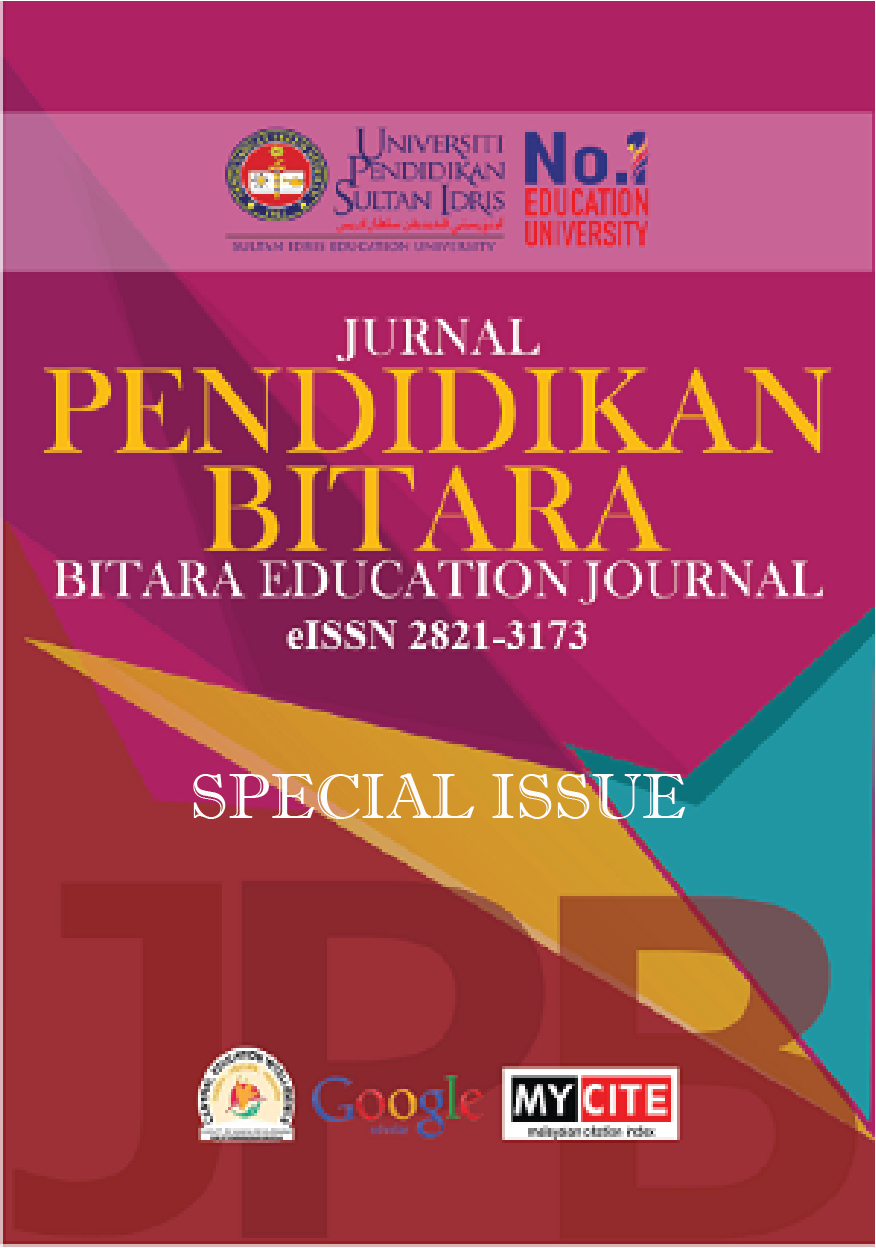The symptomatic behaviour screening tool (symbest) for early identification of developmental delays among children age 3-4.
DOI:
https://doi.org/10.37134/bitara.vol12.sp.1.2019Keywords:
Symptomatic Behaviours, Design & Development, Fuzzy DelphiAbstract
This article suggests that developmental screening, especially for behaviour symptoms, should be promptly addressed and the practice must be introduced in the early childhood education programs to reach a justified consensus between the primary care practitioners and the school system. Given that, the primary of this research is to develop a symptomatic behaviour screening tool (SymBest) for early childhood educators to identify children with symptomatic behaviours. The design and development process of SymBest is based on the theory of maturation and the theory of cognitive development along with developmentally appropriate framework (DAP). Fuzzy Delphi analysis was conducted with 18 participants from diverse backgrounds of clinical and education to gain the expert consensus on the suitability of the constructs and items representing SymBest. The findings showed that the experts have a fair degree of agreement on the constructs and the items suggested to form SymBest. The constructs and items with accepted threshold value, percentage of group consensus and fuzzy score are then organised in sequence priority to form the screening tool.
Downloads
References
Baker, B. L., Blacher, J., Crnic, K. A., & Edelbrock, C. (2002). Behavior Problems and Parenting Stress in Families of Three-Year-Old Children With and Without Developmental Delays. American Journal of Mental Retardation., 8017(December). https://doi.org/10.1352/0895-8017(2002)107<0433
Brown, M. A., Mcintyre, L. L., Crnic, K. A., Baker, B. L., & Blacher, J. (2011). Preschool Children With and Without Developmental Delay : Risk , Parenting , and Child Demandingness. Journal of Mental Health Research in Intellectual Disabilities, 5864(4), 206–226. https://doi.org/10.1080/19315864.2011.596990
Curtis, S. (2011). “ Tangible as Tissue ”: Arnold Gesell , Infant Behavior , and Film Analysis. Science in Context, 24(3), 417–442. https://doi.org/10.1017/S0269889711000172
Deslandes, S. F., Mendes, C. H. F., Pires, T. de O., & Campos, D. de S. (2010). Use of the Nominal Group Technique and the Delphi Method to draw up evaluation indicators for strategies to deal with violence against children and adolescents in Brazil, 10, 29–37.
DiStefano, C. S., & Kamphaus, R. W. (2007). Development and validation of a behavioral screener for preschool-age children. Journal of Emotional and Behavioral Disorders, 15(2), 93–102. https://doi.org/10.1177/10634266070150020401
Dobbie, A., Rhodes, M., Tysinger, J. W., & Freeman, J. (2004). Using a Modified Nominal Group Technique As a Curriculum Evaluation Tool. Family Medicine, (June), 402–406.
Don J.F.J, & Gwo H. T. (2012). Social influence on the use of Clinical Decision Support Systems : Revisiting the Unified Theory of Acceptance and Use of Technology by the fuzzy DEMATEL technique. Computers & Industrial Engineering, 62(3), 819–828. https://doi.org/10.1016/j.cie.2011.12.016
Dosman, C. F., Andrews, D., & Goulden, K. J. (2012). Evidence-based milestone ages as a framework for developmental surveillance. Pediatric Child Health.
Gesell, A. (1925). The Mental Growth of Preschool Child. New York: The Macmillan Company.
Gesell, A. (1928). Infancy and Human Growth. Toronto: The Macmillan Company.
Gesell, A., Halverson, H. M., Thompson, H., Ilg, F. L., Castner, B. M., Ames, L. B., & Amatruda, C. S. (1940). The first five years of life: A Guide to the Study of the Preschool Child. (1st ed.). London: Harper & Brothers
.
Guddemi, M., Sambrook, A., Wells, S., Randel, B., Fite, K., Selva, G., & Gagnon, K. (2014). Arnold Gesell’s Developmental Assessment Revalidation Substantiates Child-Oriented Curriculum. SAGE Open, (April-June), 1–18. https://doi.org/10.1177/2158244014528918
Hussain Iman Muhammad Ismail, Ng H. P, & Thomas, T. (2017). Paediatric Protocol.
McConnell, S., McEvoy, M., Carta, J. J., Greenwood, C. R., Kaminski, R., Good III, R. H., & Shinn, M. (1998). Measuring Growth & Development.
Miller, S. (2014). Preschool Teacher Response To Challenging Behavior: The Role Of Organizationl Climate In Referrals And Expulsions.
Miller, S., Smith-bonahue, T., & Kemple, K. (2017). Preschool teachers ’ responses to challenging behavior : The role of organizational climate in referrals and expulsions. International Research in Early Childhood Education, 8(1).
Mohd Ridhuan Mohd Jamil. (2017). Pembangunan Model Kurikulum Latihan SkiVes Bagi Program Pengajian Kejuruteraan Pembelajaran Berasaskan Kerja. University Malaya.
National Association for the Education of Young Children. (2011). Code of Ethical Conduct and Statement of Commitment. Retrieved from http://www.naeyc.org/files/naeyc/file/positions/Ethics Position Statement2011.pdf
Nye, E., Gardner, F., Hansford, L., Edwards, V., Hayes, R., Ford, T., … Edwards, V. (2016). Classroom behaviour management strategies in response to problematic behaviours of primary school children with special educational needs : views of special educational needs coordinators. Emotional and Behavioural Difficulties, 21(1), 43–60. https://doi.org/10.1080/13632752.2015.1120048
Paediatric Department Hospital Ipoh. (2008). Diagnostic Criteria for Autism Disorder As Per DSM-IV.
Ramesh C. Mishra. (2014). Piagetian Studies of Cognitive Development in India. Psychology Study, 59(September), 207–222. https://doi.org/10.1007/s12646-014-0237-y
Rice, C. E., Braun, K. V. N., Kogan, M. D., Smith, C., Kavanagh, L., & Strickland, B. (2014). Screening for Developmental Delays Among Young Children — National Survey of Children ’ s Health , United States, 2007 (Vol. 63).
Stormont, M., Reinke, W., & Herman, K. (2017). Council for Exceptional Children. Council for Exceptional Children, 37(1), 19–29. Retrieved from http://www.jstor.org/stable/23890723 Accessed:
Thelen, E., & Adolph, K. E. (1992). Arnold L. Gesell: The Paradox of Nature and Nurture. Developmental Psychology, 28(3), 368–380. https://doi.org/10.1037/0012-1649.28.3.368
Zhang, Q., & Morrison, V. (2018). Early identification within inclusive early childhood curriculum : an ethnographic study from New Zealand. Early Child Development and Care, 0(0), 1–12. https://doi.org/10.1080/03004430.2018.1471472
Downloads
Published
How to Cite
Issue
Section
License
Copyright (c) 2019 UPSI Press

This work is licensed under a Creative Commons Attribution-NonCommercial-ShareAlike 4.0 International License.





